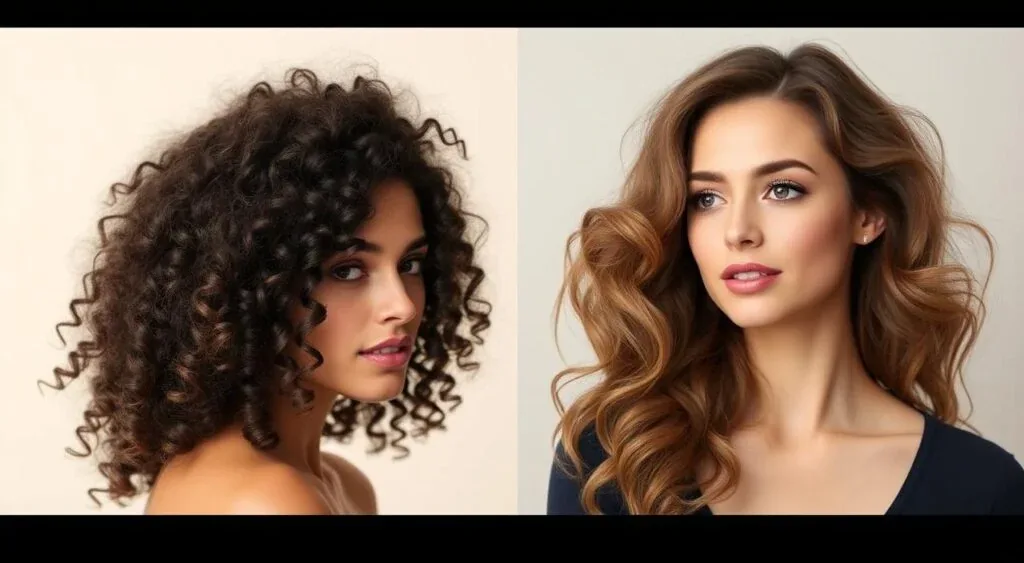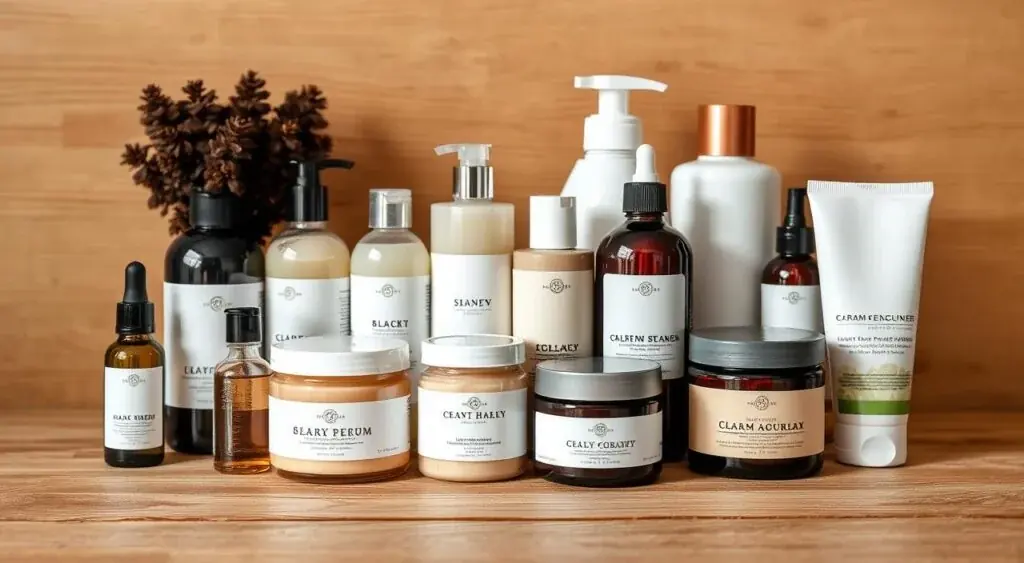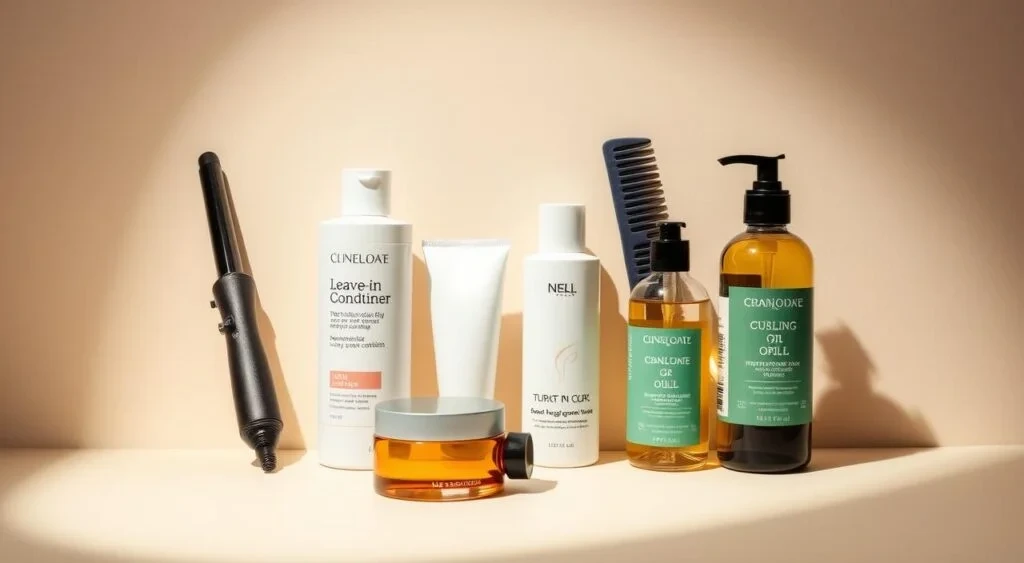Are you tired of struggling with your curly or wavy hair? Wondering what hair care routine is best for you? Understanding curly hair vs wavy hair is key to finding the right approach. Each hair type has unique needs, and with the right products and techniques, you can achieve healthy, beautiful hair that highlights your natural texture and style.
Key Takeaways
- Curly hair is categorized as Type 3, with subcategories 3A, 3B, and 3C, each with distinct curl patterns.
- Wavy hair falls under Type 2, with subcategories 2A, 2B, and 2C, each with unique wave patterns.
- Curly hair tends to be denser and more textured, while wavy hair forms loose “S” shapes and is smoother.
- Regular deep conditioning is recommended for curly hair, while lightweight moisturizers are advised for wavy hair.
- Using a hair diffuser can enhance volume and define waves or curls for both hair types.
- Hydrating ingredients are essential for managing frizz and dryness in both curly and wavy hair.
- Understanding your hair type is key to creating an effective hair care routine that brings out the best in your curly hair or wavy hair.
Understanding the Basics of Hair Texture
Knowing your hair type starts with understanding hair texture. It’s shaped by the hair follicle and the hair shaft’s structure. The follicle is the hair’s root, and its shape sets the curl pattern. The hair shaft, visible to us, influences the hair’s texture and strength.
Hair textures range from curly to straight. Each type has its own traits. For example, curly hair tends to be drier and more prone to breakage. Wavy hair, with its looser structure, often struggles with frizz and manageability.
The follicle’s shape is key in determining hair texture. Round follicles produce straight hair, while oval or elliptical ones lead to curls or waves. Knowing your follicle shape helps pick the right hair care products. The hair shaft’s structure also impacts hair texture and strength, with compact structures leading to stronger hair.
Several factors influence hair texture, including:
- Hair follicle shape
- Hair shaft structure
- Curl pattern
- Hair porosity
Understanding these factors helps you identify your hair type. This knowledge guides you in choosing the best hair care y and looks great.
Curly Hair vs Wavy Hair: Key Differences and Characteristics

A side-by-side comparison of a woman with curly hair and a woman with a natural wave, showcased against a soft, ethereal background. The curly-haired model’s locks cascade in defined, spiraling ringlets, while the wavy-haired model’s tresses flow in gentle, undulating waves. Soft, even lighting accentuates the distinct textures and movement of each hair type. The models’ expressions are serene, highlighting the unique beauty and personality of curly hair vs wavy hair. The composition is well-balanced, inviting the viewer to closely examine the key differences and characteristics of these two distinct hair types.
When comparing curly hair vs wavy hair, there are key differences to note. Knowing these differences helps you choose the right hair care routine. Curly hair has tight coils and a clear curl pattern, while loose spirals have a softer, more relaxed curl shape. Wavy hair, on the other hand, has a looser, more relaxed natural wave.
Hair classification systems show curly hair as Type 3 and wavy hair as Type 2. Within these, there are subtypes like 2A, 2B, and 2C for wavy hair, and 3A, 3B, and 3C for curly hair. Each subtype has its own texture, volume, and curl types.
Some main differences between curly hair vs wavy hair include:
- Curly hair tends to be drier and more prone to frizz than wavy hair
- Wavy hair is generally smoother and easier to manage than curly hair
- Curly hair has more volume than wavy hair
To enhance waves and add texture, salt sprays are a great option for wavy hair. They help create effortless beachy waves while adding light hold and definition. Meanwhile, for curly hair and loose spirals, salt sprays can also be used in moderation to boost volume, but they should be followed with a hydrating product to prevent dryness.
Understanding the key differences and characteristics of curly hair vs wavy hair helps you find your hair type. It’s crucial to use the right products and techniques to care for your hair, whether it’s curly or has a natural wave.ur hair, whether it’s curly or wavy.
Identifying Your Hair Type
To find the best hair care, knowing your hair type is key. Your natural pattern, curl types, and categories help you understand your hair. Many people have mixed hair types, showing different patterns on their head, especially when dealing with natural curls that vary in tightness and shape.
Look at your hair’s density and porosity. Density is measured by ponytail size, from low (less than 2 inches) to high (4 inches or more). Texture is determined by how a strand feels when rolled between your fingers—fine, medium, or coarse. When styling, applying products to damp hair can help enhance definition and prevent frizz, while those with dry hair may need extra hydration to maintain smoothness. If you have straighter hair, you may notice it gets oily faster and requires lighter products compared to wavy or curly textures.
Knowing your curl types and categories is also important. Hair types fall into four main categories: Type 1 (straight), Type 2 (wavy), Type 3 (curly), and Type 4 (coily). For instance, Type 2 hair (wavy) has a clear S pattern and needs more effort to curl, while loose ringlets in Type 3 require moisture-rich products to maintain their shape.
Identifying your hair type helps you pick the right products and styling methods. This way, you can highlight your natural beauty.
Some key factors to consider when identifying your hair type include:
- Hair formation classifications based on air-drying (straight, wavy, curly, or tight curly)
- Hair texture classifications (fine, medium, or coarse)
- Hair density classifications (low, medium, or high)
By analyzing your hair and understanding its unique traits, you can create a hair care routine that suits you. This routine will enhance your natural beauty.
The Spectrum of Wavy Hair Types

A diverse display of wavy hairstyles, showcased in a visually captivating manner. A panoramic view, captured with a wide-angle lens, highlights the spectrum of waves, from soft and subtle to bold and pronounced. Warm, natural lighting illuminates the lustrous strands, accentuating the natural movement and texture of each unique style. The subjects are positioned against a neutral, minimalist background, allowing the hair to take center stage. Subtle shadows and highlights add depth and dimension, creating a sense of harmony and diversity, reflecting the “Spectrum of Wavy Hair Types“ theme.
Wavy hair types range widely, with many subcategories. These help you understand your hair’s texture and wave pattern. Your hair might be classified as Type 2, with subcategories 2A, 2B, and 2C. While wavy hair has its unique structure, it’s important to distinguish it from Coily Hair, which falls under Type 4 and has a much tighter curl pattern.
These subcategories are based on the shape and tightness of your waves. 2A waves are looser, like an “S” shape. 2B waves look like an “S” shape, while 2C waves are tighter than an “S” shape. Many people with wavy hair fit into more than one category, often describing their hair as a mix, like 2A/2B. The curl pattern can change daily, based on hair care and products used.
On wash day, hair curls the tightest, but on other days, it can loosen up. Knowing your wavy hair type helps you pick the right products and techniques. For example, if you have 2A waves, you might like lightweight, volumizing products that add texture and definition. If you have 2B or 2C waves, you might prefer moisturizing products to define and enhance your waves. Similarly, Coily Hair requires intense hydration and curl-enhancing products to maintain its shape and prevent dryness.
- 2A: Subtle waves with a loose, relaxed texture
- 2B: More defined and tousled waves with a medium texture
- 2C: Distinct, bouncy waves with a tighter texture
By understanding your wavy hair type, you can care for and style your hair better, enhancing your natural texture antter. This enhances your natural texture and wave pattern.
Exploring Different Curly Hair Patterns
Curly hair comes in many forms, from loose waves to tight coils. Knowing your hair type is key to the right care. You might have loose waves, ringlets, tight coils, or spirals, with each hair strand needing special attention. Understanding how each natural curl pattern behaves can help you choose the best routine for your specific curl pattern.
The Andre Walker Hair Typing System breaks curly hair into three types: Type 2 (wavy), Type 3 (curly), and Type 4 (coily). Type 2 includes loose waves and ringlets, while Types 3 and 4 are known for tight coils and spirals.
- Type 2: Loose waves, ringlets, and waves
- Type 3: Tight coils, spirals, and defined curls
- Type 4: Tight corkscrews, zig-zag patterns, and highly textured hair
Knowing your hair type helps you pick the best products and care methods. Whether you have loose waveo these options next.
Essential Hair Care Routines and Products

A highly detailed, well-lit studio shot of an assortment of high-quality hair products neatly arranged on a wooden surface. The products include bottles and jars of shampoo, conditioner, hair serum, and styling creams in various natural and earthy tones. The lighting emphasizes the textures and reflections of the hair products, creating a sense of depth and clarity. The image has a clean, minimalist aesthetic that showcases the essential hair care items needed for a daily routine, reflecting the “curly hair vs wavy hair” section of the article.
When it comes to curly hair vs wavy hair, choosing the right hair care products and routines is key. Experts say natural ingredients are vital for healthy hair. Wavy hair needs moisture and definition, while curly hair requires deep hydration and frizz control.
A good hair care routine includes a gentle shampoo, nourishing conditioner, and a leave-in product. For wavy hair, a lightweight styling product works best, while curly hair benefits from a deeply hydrating mask.
- Volumizing mousses to add body and texture
- Hydrating serums to lock in moisture
- Nourishing masks to repair and restore hair
By following the right curly hair vs wavy hair care routines and using the best products, your hair will stay healthy and beautiful. Always choose products with natural ingredients and stick to a hair care routine that suits your hair type.ealthy and beautiful. Always choose products with natural ingredients. Follow a hair care routine that suits your hair type.
Styling Techniques for Your Hair Type
Knowing your hair type is key to styling it right. When comparing curly hair vs wavy hair, the right techniques can make all the difference in how your hair looks and feels. For those with a curly hair type, methods like the “Praying Hands Method” or “Wet Plopping” can enhance curls and cut down frizz. Wavy hair, on the other hand, benefits from techniques like the “Smasters Technique” or “Raking In” to boost texture and definition.
Here are some tips for styling your hair based on your hair type:
- For a curly hair type, use a curl cream or gel to define curls and reduce frizz.
- For wavy hair, use a light-hold styling product to enhance texture and definition.
- Apply styling products on soaking-wet hair to prevent weighing down the texture.
- Scrunching can help enhance loose textures in wavy hair.
Understanding curly hair vs wavy hair and using the right techniques is the secret to great-looking hair. With a bit of practice and patience, you’ll find the perfect styling routine for your hair. is the secret to great-looking hair. With a bit of practice and patience, you’ll find the perfect styling routine for your hair.
Common Challenges and Solutions

A well-lit, close-up shot of a diverse collection of hair styling products and tools for managing curly hair, including a curling iron, a leave-in conditioner, a wide-tooth comb, and a nourishing hair oil. The items are arranged artfully on a minimalist, neutral-toned background, casting soft shadows and highlighting their textures and colors. The overall mood is sleek, modern, and informative, conveying a sense of practical solutions for the common challenges of managing curly hair.
Dealing with curly and wavy hair can be tough. You might face frizz, humidity, and damage. But, there are ways to tackle these problems. To fight frizz, try sulfate-free shampoos and conditioners. Also, use a leave-in conditioner to keep your curls moist.
Getting the right volume and definition can be hard. Use a diffuser on your hairdryer to boost curls at the roots. For more volume, apply a lightweight hair mousse or foam. For better definition, curl-enhancing creams, gels, or serums work well.
Preventing damage and breakage is key. Regular trims are essential. Limit heat styling and use tools at lower temperatures. By following these tips, you can keep your curls healthy and vibrant.
- Use sulfate-free shampoos and conditioners
- Apply a leave-in conditioner post-wash
- Use a diffuser attachment on your hairdryer
- Apply a lightweight hair mousse or foam
- Use curl-enhancing products
Conclusion
As we wrap up our look at curly hair vs wavy hair, the key message is to love your natural hair. Whether you have bouncy waves or tight curls, your hair is special and stunning. By knowing your hair type and caring for it right, you can get healthy, vibrant hair that shows off your style.
Your hair is a way to express yourself. Try out different styles, products, and protective hairstyles to see what suits you. Celebrate how versatile your hair is and let its natural beauty shine. With the right care, you can make the most of your hair and feel confident in your own skin.
Love and care for your natural hair pattern. It reflects your unique self, so wear it proudly. By taking care of your hair, you’ll not only get amazing results but also appreciate the beauty of diversity in all of us.
FAQs:
1. What are the key differences between curly and wavy hair?
Curly hair has tight coils and a clear curl pattern. Wavy hair has a looser, softer wave. Curly hair often has more volume and a tighter curl. Wavy hair is softer and has a more relaxed wave.
2. How do I identify my hair type?
To find out your hair type, look at your natural pattern. Understand curl types and categories. Check your hair density and porosity. This helps you know if you have curly, wavy, or straight hair and what care it needs.
3. What are the different types of wavy hair?
Wavy hair includes many textures and wave patterns. It ranges from loose, beachy waves to tighter, more defined waves. Types include Type 2A, Type 2B, and Type 2C.
4. What are the different types of curly hair patterns?
Curly hair patterns vary widely. They can be loose, bouncy curls or tight, defined coils. Patterns include loose curls, tight coils, and spirals.
5. What are the essential hair care products for curly and wavy hair?
For wavy hair, use lightweight shampoos, conditioners, and styling products. These should not weigh down your hair. For curly hair, you need cleansing conditioners, deep conditioners, and curl-enhancing creams. Styling gels or mousses are also key.
6. What are some common challenges with curly and wavy hair, and how can I address them?
Challenges include frizz, humidity, managing volume and definition, and preventing damage. Use the right products and styling techniques. Treatments can also help keep your hair healthy and well-maintained.
